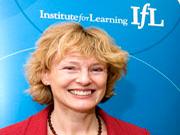Engineering apprentices assess their teaching

A gecko might not be the first thing that springs to mind when you think about high-tech engineering, but the glue-free adhesive tape designed by Professor Andre Geim at the University of Manchester was modelled on the gecko’s setae – tiny bristles on their feet that adhere to surfaces. Studying and imitating nature’s best designs and processes to solve human problems is a burgeoning scientific field, and I was intrigued to hear from five engineering apprentices at BAE Systems in Preston about how they investigate biomimicry as an aid to understanding and a known source of innovation for engineering breakthroughs. Seeking parallels between engineering principles and nature is one of the many ways in which teachers and trainers encourage engineering apprentices to develop a passion for asking questions and being curious.
Understanding and supporting brilliant teaching and learning in further education and skills is central to the work of IfL, the professional body for teachers and trainers, so I was extremely interested to hear the apprentices’ views about their programme and their insights into what they really value about their teaching and training. I am always keen to know what learners think about how they learn and the characteristics of good teaching.
The five young apprentices, who kindly spent an hour chatting with me after I had arrived somewhat early for a meeting at the site, spend some of their time with Runshaw College teachers, learning about specific areas, such as developing IT skills. Their time at BAE Systems has an ‘upstairs, downstairs’ arrangement. During the early part of their apprenticeship, they spend more time with teachers in the further education rooms upstairs, then increasingly benefit from hands-on practical experience and experimentation in the work areas downstairs, with their teachers setting tasks and supporting them. On and off-the-job training are integrated, and frequent visits upstairs for review, reflection, reinforcement of learning and more in-depth theory with the FE teachers help accelerate their learning.
It is important to these young apprentices that their teachers really know BAE Systems and how the company works, that they understand the complex business contexts and appreciate the confidentiality needed in certain areas. From their perspective, the strong partnership between BAE Systems and Runshaw College’s teachers is crucial to the success of the programme.
They want teaching that gives a clear sense of the overall purpose of the learning, whether learning to use a lathe for the first time or having progressed to working with world-class precision lathes that produce the finest and most resilient parts of an aeroplane engine. Seeing the final products BAE Systems makes – engines, planes, security products and other hi-tech products and systems – is of course very impressive and very tangible. The apprentices appreciate their teachers acknowledging that learning can be hard and explaining why they have to persevere with overcoming particular pain barriers – learning to solve a hard equation, for example, because a particular aircraft engineering application requires it. The range of placements available within the company means they can learn widely and get chances for new learning and to apply their learning across many different settings.
Teaching that draws on real-life examples is with a ‘must have’ for the apprentices: for example, they were positive about a teacher who ran his own business, and a session in which they discussed real-life uses of carbon fibres. They value collaborative teaching and learning methods that are based on inquiry and curiosity, followed by trial and error and feedback, which all work to hone their skills and build deep understanding.
It is not enough for their teachers to be subject or technical engineering experts: they need to understand how learning happens best, make learning interactive and help apprentices understand the ways in which they learn best. This accords with IfL’s model of dual professionalism, which sees teachers and trainers as experts in teaching and training methods as well as in their specialist subject or vocation.
The apprentices’ teachers give plenty of scope for project team working and experimentation, and strongly encourage creativity. One of the tasks they were given was to design a water pump that could pump water as fast as possible. Incorporating a competitive element or time restriction makes the learning more exciting, as does being given the opportunity to compete in WorldSkills and other such events.
Celebrating success is motivating. One apprentice worked on developing a prototype for wing flaps, which the company is adopting for engines and flight. Everyone at the site talks about the value of the apprentice’s fresh ideas that led to this breakthrough.
It was a joy to see these apprentices’ enthusiasm for their learning. I am very grateful for the time they spent sharing their very thoughtful insights about excellent teaching and training. The teaching at BAE Systems filled me with optimism about what can be achieved for apprentices, and in turn the economy, through brilliant teaching and learning.
Toni Fazaeli is the chief executive of the Institute for Learning (IfL), the professional body for teachers, trainers, tutors and student teachers across the further education and skills sector











Responses